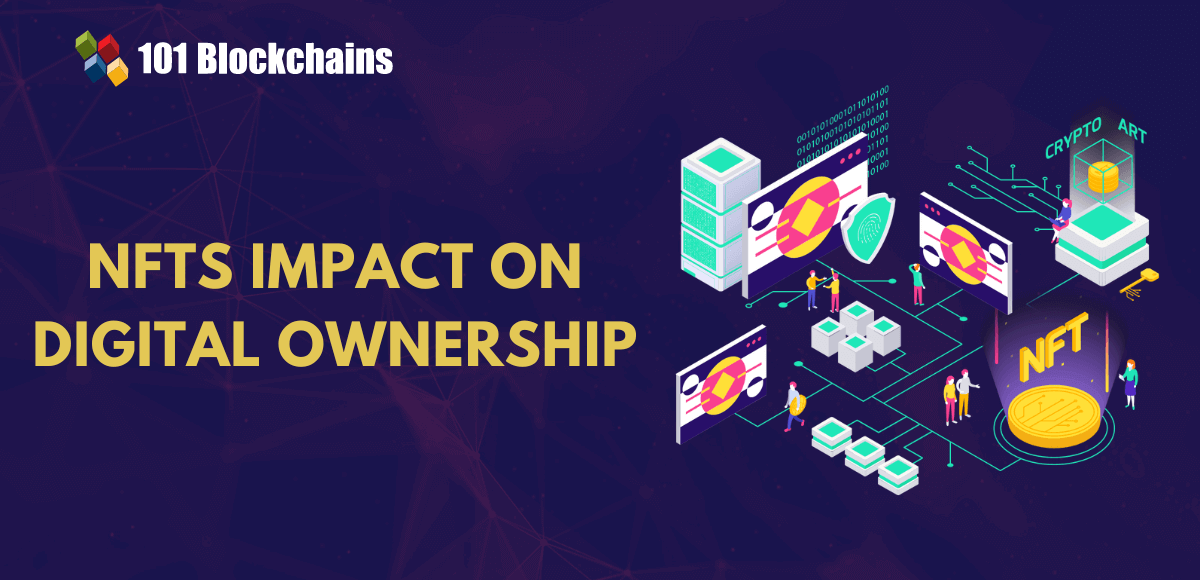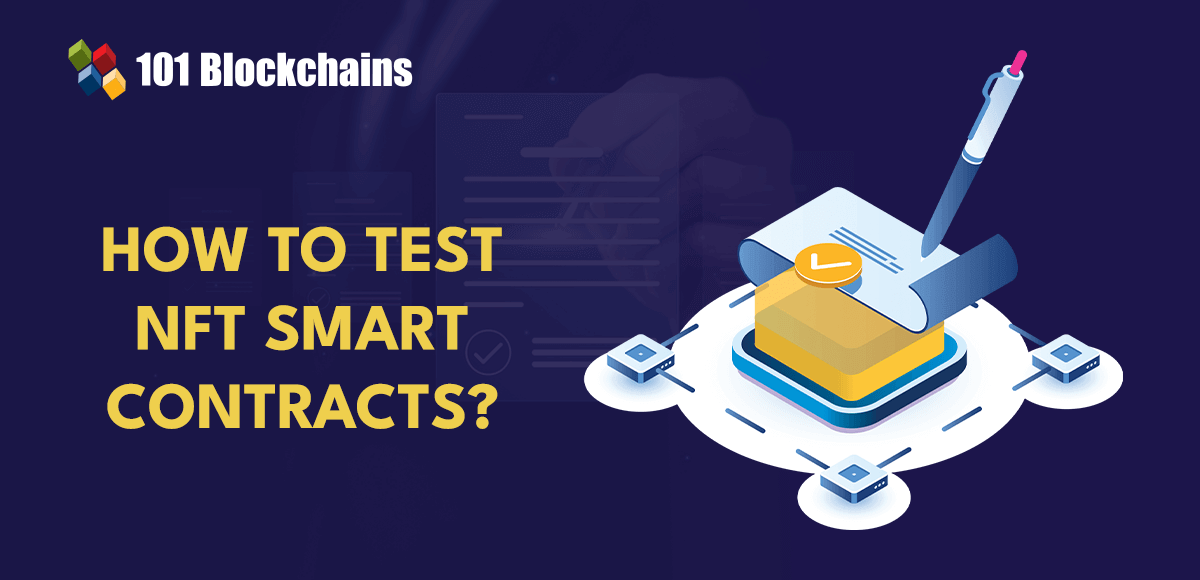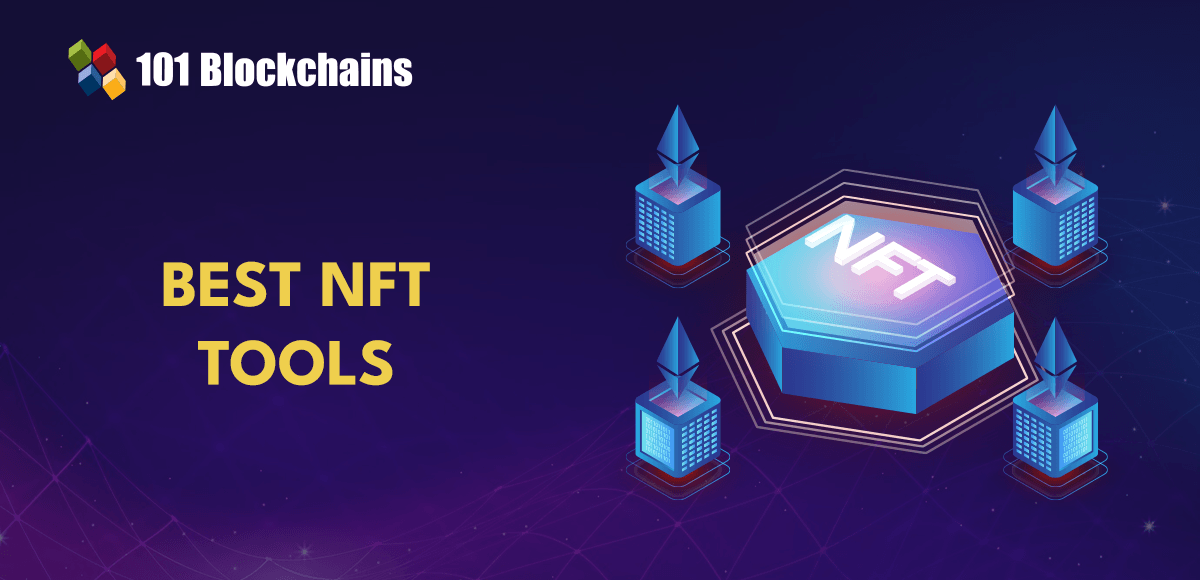Learn how blockchain truly works, master key definitions, and uncover what makes smart contracts so "smart." Dive into the fundamentals, gain valuable insights, and start your blockchain journey today!
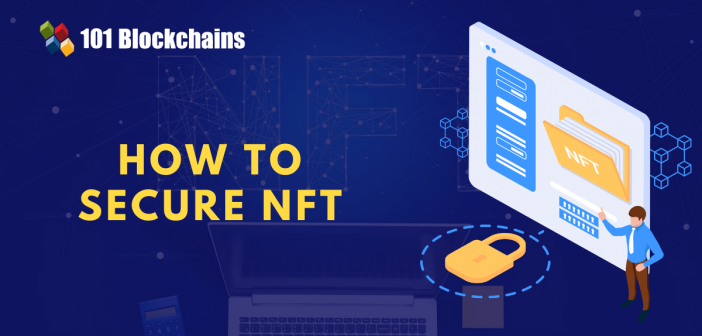
- NFT
Georgia Weston
- on December 02, 2022
NFT Security Tips & Best Practices
Non-fungible tokens soared in popularity by huge margins following their introduction to the mainstream market in 2021. The market for NFTs has undoubtedly witnessed massive growth, with NFT sales mounting up to $25 billion last year. At the same time, NFTs have garnered interest from crypto enthusiasts as well as new users. How are NFT security tips relevant for using the new class of unique digital assets?
Just because celebrities such as Paris Hilton and Jay-Z are buying into NFT collections such as Bored Ape Yacht Club and CryptoPunks, you could not jump randomly into any NFT project. The growing popularity of NFTs and the value associated with them have been attracting hackers, scammers, and other malicious agents. The different cases of NFT theft and hacks could affect the motivation of users to invest in NFTs.
Therefore, a clear outline of NFT security tips and best practices is mandatory for maintaining the safety of valuable assets. With NFTs valued at thousands of dollars and some high-end pieces fetching millions, NFT security is an unavoidable priority. The following discussion points out some of the best practices you need to follow for securing NFTs. Most important of all, the post also outlines the notable security threats for non-fungible tokens.
Importance of NFTs
Non-fungible tokens are unique digital assets that relate to specific assets represented on blockchain networks. The tokens are generally attributed to digital art, video games, music, and other variants of digital media. NFTs could also represent real-world assets such as real estate and collectibles. One of the unique highlights of non-fungible tokens refers to the verification of true ownership of assets, digital and physical. Therefore, NFTs could also find applications in many other use cases across different sectors with promising value advantages.
Want to get an in-depth understanding of non-fungible tokens (NFTs)? Enroll now in the NFT Fundamentals Course.
Significance of NFT Safety
The technical foundation of NFTs on blockchain technology offers the assurance of cryptographic security. However, NFT security and safety are of utmost importance, as any malicious actor could steal your NFTs. Without proper safeguards, hackers can use phishing attacks or other vulnerabilities to obtain access to your NFT wallets.
A small mistake, such as clicking on an unverified malicious link, can lead to the exposure of your login information alongside the theft of your valuable assets. In addition, you have many other threats to the safety of your non-fungible tokens. If you want to invest in NFTs, then you must be aware of the best practices to ensure the security of every aspect of NFT transactions.
Build your identity as a certified blockchain expert with 101 Blockchains’ Blockchain Certifications designed to provide enhanced career prospects.
NFT Scams
Most people would assume that non-fungible tokens are inherently secure as they are stored in crypto wallets and rely on blockchain technology for exchanges. Therefore, NFT owners are also vulnerable to the same security threats that affect cryptocurrencies. The answers to ‘Is NFT safe?’ might not fetch you some favorable results, as evident in popular examples. One of the recent attacks happened in February 2022, which resulted in the theft of NFTs worth $1.7 million on OpenSea. In addition, renowned play-to-earn NFT platform Axie Infinity lost around $600 million in a breach of the Ronin Bridge.
Blockchain has been tailored to offer comparatively better security in comparison to centralized systems. However, users have to take note of threats such as phishing attacks and malware infections, or hacking of NFT wallets. In some cases, a compromised NFT platform or wallet could lead to the loss of valuable digital assets. Let us take a look at all the possible risks to NFT security before finding out the security best practices.
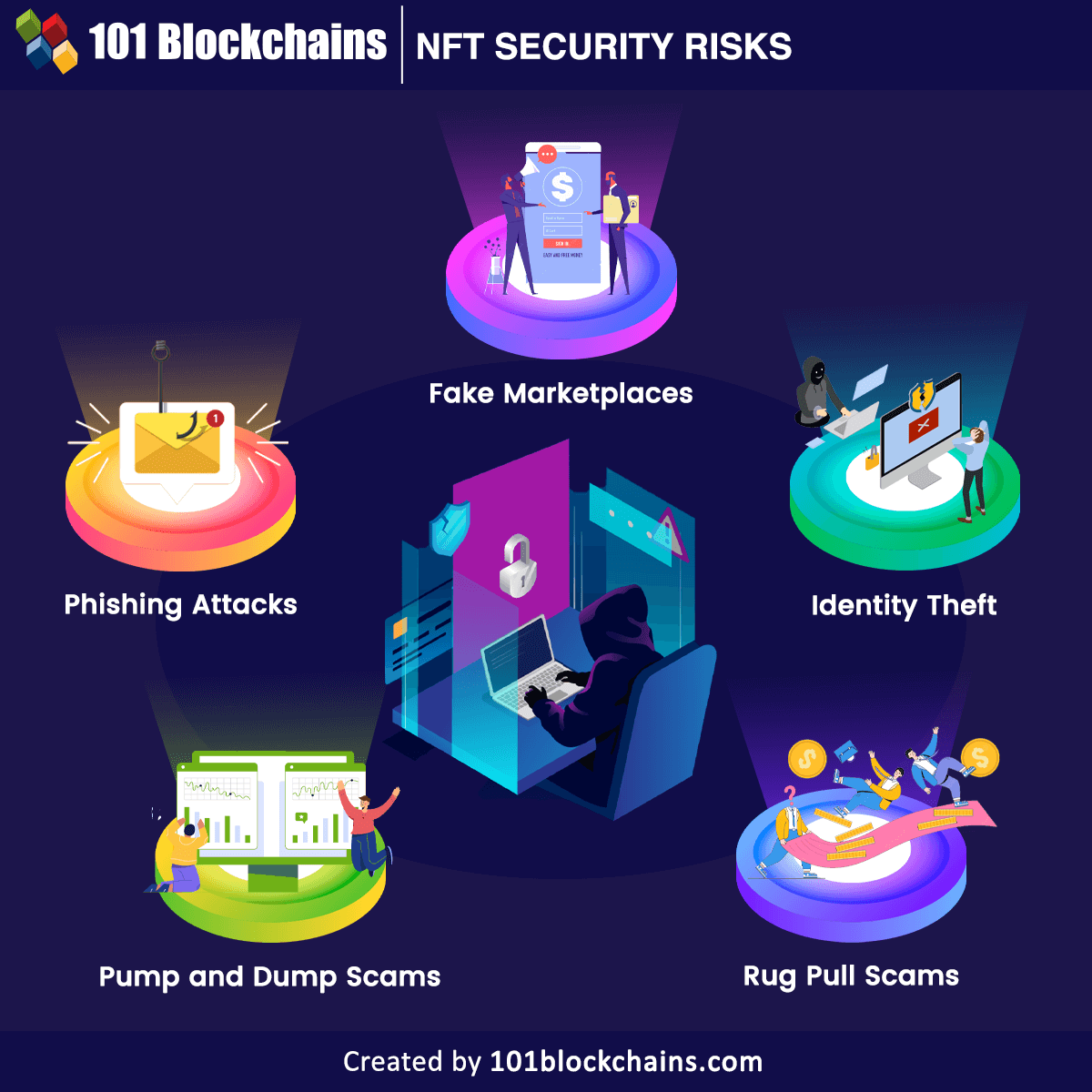
-
Fake Marketplaces
The easiest way for any beginner to purchase or sell a non-fungible token is through NFT marketplaces. What do you do when you shop for products online? You must have looked through the offers by multiple retailers before making your final choice. The same is applicable to NFTs, as you could find multiple NFT marketplaces and platforms for interacting with non-fungible tokens.
One of the key entries among NFT safety tips refers to the selection of trusted NFT marketplaces and platforms. Make sure you invest some time in research regarding the NFT marketplace or trading platform. In-depth research into the origins and goals of a trading platform could help in verifying its authenticity. You would never want your private keys and seed phrase on a malicious NFT marketplace, which could empty your wallet without notice.
-
Phishing Attacks
Another common entry among NFT scams would refer to phishing attacks. The use of phishing for NFT hacks could take different forms, depending on the hackers. Phishing attacks are carried out through emails claiming to offer free NFTs or an opportunity to buy NFTs from an exclusive collection. Most important of all, phishing emails include a link that appears legitimate and leads users to fake platforms.
The list of NFT best practices for security always prioritizes phishing attacks, as they keep evolving in terms of content. For example, some phishing emails can feature the message in the exact style or font of the original marketplace or trading platform. If you fall for the ‘link’ trap, you might end up compromising your seed phrase and private keys.
-
Identity Theft
You might have heard about fake calls from scammers claiming to offer huge amounts of money as rewards. The dynamics of the NFT world could make any unsuspecting victim believe every offer to be a new opportunity. Hackers could use the appealing nature of NFTs as a tool in their attacks which rely on playing as a representative of reliable NFT platforms.
The identity theft aspect could create problems for users who may become victims of hackers. The list of NFT security tips focuses on staying away from any calls claiming to be from reputed NFT marketplaces or platforms. Some of them could claim to offer free support or intimidate you with warnings about losing your assets. Hackers use the fear of security to compromise security by stealing the user’s credentials by deception.
Learn the concept, elements, future and use cases of NFTs from Non Fungible Tokens (NFTS) E-Book
-
Rug Pull Scams
The dynamic world of NFTs is unpredictable, to say the least. Just like cryptocurrencies and dApp projects, NFTs are also subject to the threat of rug pull scams. Rug pull scams involve gaining the trust of buyers and offering them a false sense of security. For example, a new NFT collection or a grand giveaway launches and garners social media hype through targeted promotion.
Once it has accumulated enough users for a huge sum of money, the developers or founders would run away with all the money. All you would be left with are NFTs without any real value. A notable example of rug pull scams is that of the Frosties collection. The question of ‘is NFT safe’ becomes irrelevant considering the loss of around $2.8 billion to rug pull scams alone in 2021.
-
Pump and Dump Scams
The names of NFT security risks have a way of explaining a lot about their definition. Pump and dump schemes are generally carried out with the efforts of a group of malicious agents. The scam involves pumping money into a specific NFT project to elevate its value by huge margins in short periods of time. As a result, the project could garner the attention of prospective NFT buyers alongside an artificial rise in value. Then, the hackers could sell off the NFTs to secure profits, and the price of NFTs could fall down.
Start learning Non-Fungible Token with World’s first NFT Skill Path with quality resources tailored by industry experts Now!
How Can You Protect Your NFTs?
The list of threats to NFT security and safety also includes many other mentions, such as social engineering attacks and fake NFT collections. On the other hand, you could find many recommended best practices for securing NFTs. You can use the following best practices for strengthening your defense against the various security threats to non-fungible tokens.
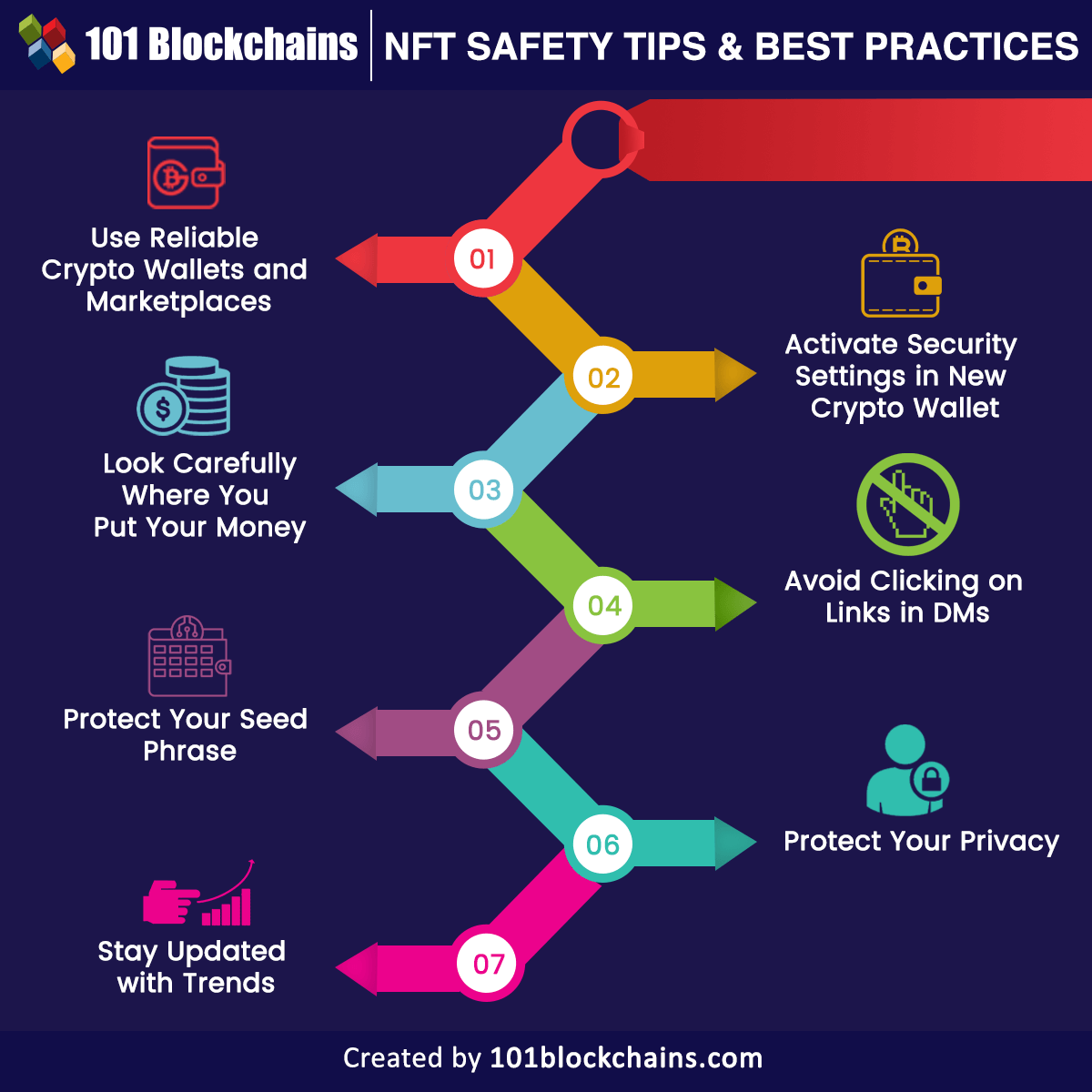
-
Use Reliable Crypto Wallets and Marketplaces
The easiest solution to avoid malicious NFT trading platforms would be to set up your NFT account on a reliable wallet. For example, you can choose Coinbase or Ledger and Exodus wallets, depending on your choice. Hardware wallets are the best bet when it comes to security. At the same time, NFT best practices for security also call for attention to the top NFT marketplace, OpenSea.
-
Activate Security Settings in New Crypto Wallet
If you want to utilize a popular crypto wallet, you should look for security protocols that can safeguard your NFTs. The security protocols are not generally enabled with the initial settings of the wallet, and you have to activate them. For example, options for two-factor authentication or firewalls against phishing attacks are a few of the security settings you must enable on NFT wallets.
-
Look Carefully Where You Put Your Money
NFT collections are the hottest craze among enthusiasts and new adopters. Popular choices such as BAYC and CryptoPunks have registered exceptional performance in secondary sales. However, the popularity of NFT collections has invited the malice of fraudulent platforms and collections. The answers to “How do you protect an NFT?” would call for a strong emphasis on research regarding NFT projects.
It is one of the traditional methods for checking any crypto project before putting your money in them. Investors should look into the details of the NFT project and the details of its founders. In addition, you must also try to identify the goals underlying the project and its roadmap for the future. Any credible NFT collection would feature all these details alongside a clear purpose for users and the decentralized tech ecosystem.
Excited to develop an in-depth understanding of solidity’s best practices and the tools needed for developing and testing an NFT marketplace, Enroll now in the NFT Development Course
-
Avoid Clicking on Links in DMs
DMs or direct messages are one of the innovative ways to scam users of their NFTs. Hackers can create fake websites and send the link to a victim so that they can develop an interaction. Random links in your DMs will always be a red flag you must avoid at all costs.
-
Protect Your Seed Phrase
The outline of NFT security best practices would remain incomplete without emphasizing the safeguards for the seed phrase. You should know that the seed phrase for your NFT wallet serves as a password recovery tool. Hackers can set up your wallet on another device and gain access to private keys for all your transactions in a wallet by using the seed phrase.
Therefore, it is important to avoid writing your seed phrase in any registration form, or other application prompts. At the same time, you must also follow the necessary best practices for securing your seed phrase. Remember that you should never store your seed phrase on a device connected to the internet. On the contrary, you can try writing it on a piece of paper or metal and save it somewhere secure.
-
Protect Your Privacy
Owning an NFT is a status symbol in digital communities, especially on social media platforms such as Twitter. Many NFT collectors proudly show off their non-fungible tokens without the fear of consequences. Another notable answer to “How do you protect an NFT?” refers to avoiding the use of NFT avatars or domain names interpretable to hackers.
Blockchain technology offers transparency into transactions and wallet data. Malicious entities could utilize the details of their addresses and focus on targeted phishing attacks. Subsequently, NFT owners could become victims of such vulnerabilities and leak their wallet information.
-
Stay Updated with Trends
The best approach for safety against NFT security threats refers to knowledge of the latest trends. You need to understand the events happening in the NFT industry and identify the latest news about security breaches. Update your knowledge about the evolving security threats and prepare for every possible scenario.
Start your journey to becoming an expert in Web3 security skills with the guidance of industry experts through Web3 Security Expert Career Path
Final Words
The final impression regarding NFT safety tips suggests that being careful about the security of your own assets does not take much effort. Although you have to be attentive to the different security best practices, the practices do not have any complexity. On the contrary, you can follow the best practices for NFT security with a few simple steps.
For example, enabling two-factor authentication on NFT wallets or selection of credible NFT marketplaces and trading platforms. The adoption of NFTs depends profoundly on the level of trust in using valuable assets with safety. Learn more about NFTs and become a certified NFT expert.
*Disclaimer: The article should not be taken as, and is not intended to provide any investment advice. Claims made in this article do not constitute investment advice and should not be taken as such. 101 Blockchains shall not be responsible for any loss sustained by any person who relies on this article. Do your own research!




